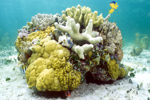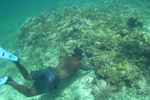

Spiny Lobster (Panulirus argus)
photo: K. Holmes
The Caribbean spiny lobster (Panulirus argus), found in the Gulf of Mexico, the Caribbean Sea, and the Western Atlantic Ocean from North Carolina, U.S.A., to Rio de Janeiro, Brazil (FAO 2004), is a member of the ecologically and economically important rock or spiny lobster family, Panuliridae. Apart from supporting lucrative commercial and recreational fisheries, these gregarious crustaceans are known for their migratory behavior, which can involve single-file group movements of juveniles and adults from shallow to deeper waters, related to seasonal, severe weather, or other factors (Herrnkind et al. undated). Larvae often disperse across national territories, so that management in one country may affect populations in others. This arthropod is omnivorous, scavenging mainly nocturnally on diverse kinds of plant and animal matter, including crustaceans and mollusks (Bliss 1982, Briones-Fourzan et al. 2003). Lobsters, in turn, are prey for various organisms, including sharks, groupers, snappers, sea turtles, octopuses, and humans.
Spiny lobsters, commonly known as crawfish, are harvested throughout their range. This multi-million dollar fishery is one of the most valuable in the Caribbean (Cascorbi 2004, Bene and Tewfik 2001). Capture methods include free diving, use of traps, spears, and trawls (Bene and Tewfik 2001, FAO 2004). Spiny lobster fisheries in Florida and The Bahamas are intense, but do not result in notable harm to habitats and ecosystems, and levels of by-catch are low (Davis 1977, Davis and Dodrill 1989, Eggleston et al. 2003, Cascorbi 2004). In some areas, such as the Turks and Caicos, Panulirus argus may be harvested jointly with the Queen Conch (Bene and Tewfik 2001). Caribbean spiny lobsters are not classified as endangered or threatened, although they are listed on the SPAW protocol (UNEP undated). Aspects of their biology, such as rapid growth, a relatively early age of sexual maturity, high reproductive potential, and the potential for long-distance dispersal may contribute to a relatively low susceptibility to extirpation from overfishing (Cascorbi 2004). Fisheries are regulated, including measures such as closures during spawning season, trap-reduction programs and legal size and bag limits. Also illegal in some countries is harvesting of egg-bearing females, and fishing with firearms or explosives. Effectiveness of enforcement varies regionally (Cascorbi 2004). Marine reserves protect lobsters and their habitats, although very small protected areas may be inadequate (Eggleston and Dahlgren 2001).
Spiny lobsters occupy a variety of environments throughout their life cycle, which spans up to 30 years. Reproduction and fertilization occur in offshore reef areas, generally during late spring or early summer. During the mating process, males deposit a sticky fluid containing sperm onto the female's abdomen; this fertilizes the eggs upon release (Herrnkind et al. undated, Bliss 1982). Fertilized eggs remain under the female's tail until they hatch, and clutch size varies with location and fishing pressure. In the Dry Tortugas, for example, lobsters became reproductively active at larger sizes, and the average number of eggs is higher than in a south Florida fishery (Bertelsen and Matthews 2001). Eggs hatch into transparent phyllosome larvae that drift offshore with the surface currents. This pelagic stage generally lasts 6-12 months, resulting in long distance dispersal spanning hundreds of kilometers (Herrnkind et al. undated). They next molt into free-swimming puerulus postlarvae, which leave the open ocean to settle in nearshore vegetated benthic areas such as sea grasses, algal beds, or mangroves (Acosta et al. 1997, Acosta 1999, Butler et al. 1997). This process is thought to vary with characteristics of the nursery habitat, postlarval supply, environmental factors, fishing pressure, and oceanographic circulation (Lipcius et al. 1997, Butler et al. 2001, 1997, Cruz et al. 2001, Lipcius et al. 2001, Yeung et al. 2001). Postlarvae metamorphose into juveniles, whose movements are asocial and initially restricted to sheltered areas such as algal beds (Butler et al. 1997, Herrnkind et al. undated). As time goes on they become increasingly vagile and social, living in small aggregations inside crevices, under rocks, seaweeds, sponges and corals (Eggleston and Dahlgren 2001). As lobsters approach maturity, which may occur around 2-3 years of age, they move to deeper waters in coral reef systems where reproduction occurs (Herrnkind et al. undated).
Acosta, C.A. 1999. Benthic dispersal of Caribbean spiny lobsters among insular habitats: implications for the conservation of exploited marine species. Conservation Biology 13(3): 603-612.
Acosta, C.A. and M.J. Butler, IV. 1997. Role of mangrove habitat as a nursery for juvenile spiny lobster, Panulirus argus, in Belize. Marine and Freshwater Research 48: 721-727.
Bene, C. and A. Tewfik. 2001. Fishing Effort Allocation and Fishermen's Decision Making Process in a Multi-Species Small-Scale Fishery: Analysis of the Conch and Lobster Fishery in Turks and Caicos Islands. Human Ecology 29 (2): 157-186.
Bertelsen, R.D. and T.R. Matthews. 2001. Fecundity dynamics of female spiny lobster (Panulirus argus) in a south Florida fishery and Dry Tortugas National Park lobster sanctuary. Marine Freshwater Research 52: 1559-1565.
Bliss, D. 1982. Shrimps, Lobsters and Crabs. New Century Publishers, Piscataway NJ: 242 pp.
Briones-Fourzan P, V.C.F. de Lara, E. Lozano-Alvarez, and J. Estrada-Olivo. 2003. Feeding ecology of the three juvenile phases of the spiny lobster Panulirus argus in a tropical reef lagoon. Marine Biology 142 (5): 855-865.
Butler, M.J., IV, W.F. Herrnkind and J.H. Hunt. 1997. Factors affecting the recruitment of juvenile Caribbean spiny lobsters dwelling in macroalgae. Bulletin of Marine Science 61: 3-19.
Butler, M.J., IV, T. Dolan, W. Herrnkind and J. Hunt. 2001, Modeling the effect of spatial variation in postlarval supply and habitat structure on recruitment of Caribbean spiny lobster. Marine Freshwater Research 52: 1243-52.
Cascorbi, A. 2004. Seafood Watch Seafood Report: Caribbean Spiny Lobster Panulirus argus. Available from http://www.mbayaq.org/cr/cr_seafoodwatch/content/
media/MBA_SeafoodWatch_CarribbeanSpinyLobsterReport.pdf
Cruz, R., E. Diaz, M. Baez and R. Adriano. 2001. Variability in recruitment of multiple life stages of the Caribbean spiny lobster, Panulirus argus, in the Gulf of Batabano, Cuba. Marine Freshwater Research 52: 1263-70.
Davis, G.E. 1977. Effects of recreational harvest on a spiny lobster, Panulirus argus, population. Bulletin of Marine Science 27(2) 223-236.
Davis, G.E. and J.W. Dodrill. 1989. Recreational fishery and population dynamics of spiny lobsters, Panulirus argus, in Florida Bay, Everglades National Park. Bulletin of Marine Science 44: 78-88.
Eggleston, D.B. and C.P. Dahlgren. 2001. Distribution and abundance of Caribbean spiny lobsters in the Key West National Wildlife Refuge: relationship to habitat features and impact of an intensive recreational fishery. Marine Freshwater Research 52: 1567-76.
Eggleston, D.B., E.G. Johnson, G.T. Kellison, and D.A. Nadeau. 2003. Intense removal and non-saturating functional responses by recreational divers on spiny lobster Panulirus argus. Marine Ecology Progress Series 257: 197-207.
FAO. 2004. FIGIS Species Fact Sheets Panulirus argus (Latreille, 1804). A world overview of species of interest to fisheries. Chapter: Panulirus argus. Available from http://www.fao.org/figis/servlet/species?fid=3445
Herrnkind, W.F. et al. Undated. Life History and Ecology of the Caribbean spiny lobster. Available from http://bio.fsu.edu/~herrnlab/lifehistory.html
Lipcius, R.N., W.T. Stockhausen, D.B. Eggleston, L.S. Marshall, Jr., and B. Hickey. 1997. Hydrodynamic decoupling of recruitment, habitat quality and adult abundance in the Caribbean spiny lobster: Source-sink dynamics? Marine and Freshwater Research 48(8): 807-815.
Lipcius, R.N., W.T. Stockhausen, and D.B. Eggleston 2001. Marine reserves for Caribbean spiny lobster: Empirical evaluation and theoretical metapopulation recruitment dynamics. Marine and Freshwater Research 52(8): 1589-1598.
UNEP. Undated. The SPAW Programme Specially Protected Areas and Wildlife in the Wider Caribbean Region. Available from http://www.cep.unep.org/programmes/spaw/spaw.html
Yueng, C., D.L. Jones, M.M. Criales, T.L. Jackson, and W.J. Richards. 2001. Influence of coastal eddies and counter-currents on the influx of spiny lobster, Panulirus argus, postlarvae into Florida Bay. Marine Freshwater Research 52: 1217-32.






